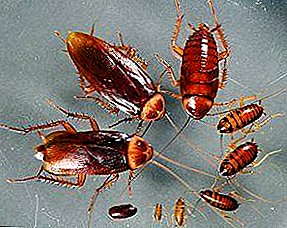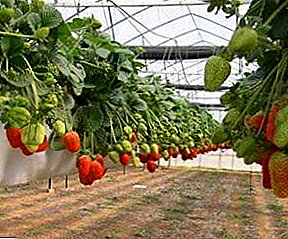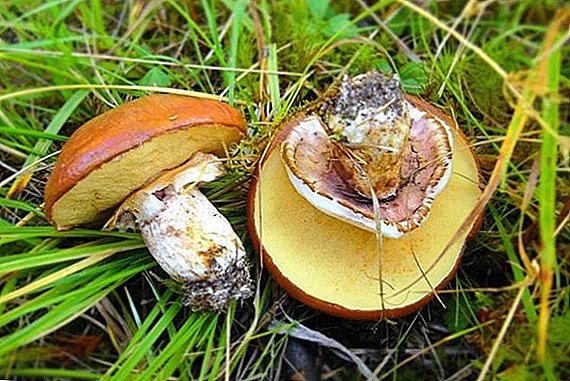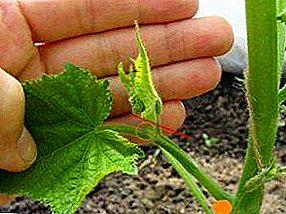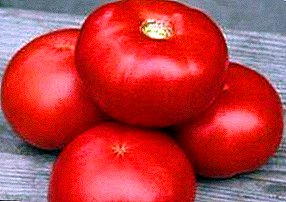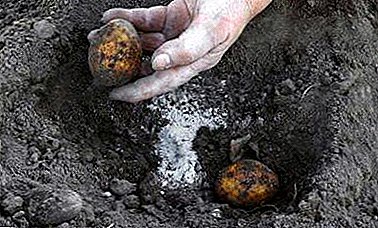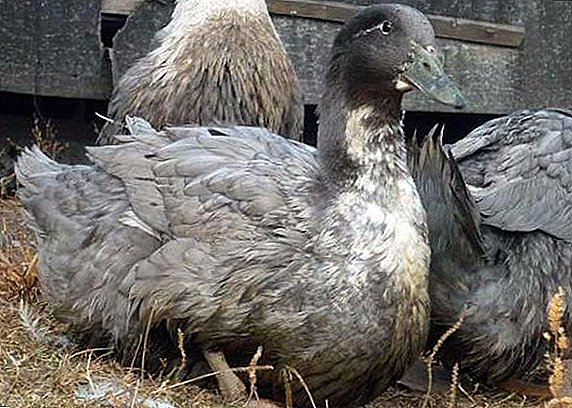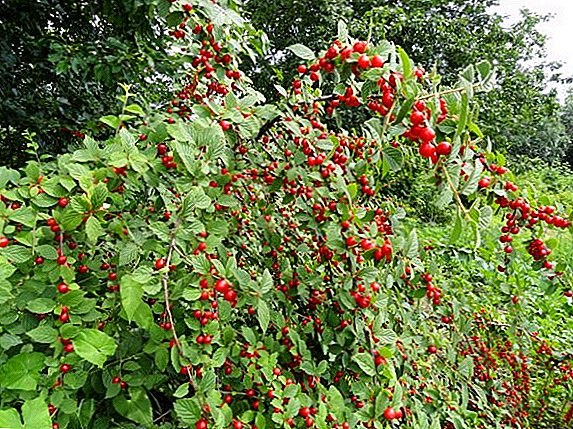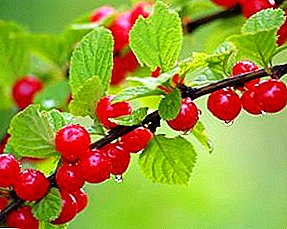 Felt cherry - sprawling bush tree that reaches two meters in height. It has a broad, ovate or slightly flattened crown, ribbed wrinkled leaves and rounded red-orange berries that thickly stick around the branches. This bush tree is also highly resistant to pests and diseases, although, like many other varieties, it is prone to attacks of coccomycosis.
Felt cherry - sprawling bush tree that reaches two meters in height. It has a broad, ovate or slightly flattened crown, ribbed wrinkled leaves and rounded red-orange berries that thickly stick around the branches. This bush tree is also highly resistant to pests and diseases, although, like many other varieties, it is prone to attacks of coccomycosis.
When choosing a suitable grade of felt cherry, many gardeners prefer the following options.
"Spark"
If you prefer this variety, then you probably already know that in the future you will get large light red berries, the mass of which can reach 4 g. They have a thick, juicy sour-sweet pulp, the maximum maturation of which falls on the second half of July. The skin of the berries is quite thin and is not separated from the pulp. Such fruits are suitable both for fresh consumption and for making jam, juice or even wine.
The life span of the cherry light "Spark" is usually 14 years, and until that time it reaches more than two meters in height and 2.8 m in width (crown size). Perennial branches have a dark gray color and are characterized by flaky bark, while annual shoots are dark brown in color. Small buds tightly pressed to the shoots, and their fruit copies are formed on the terminal annual shoots, as well as on the shortened and bouquet fruit sprigs (up to 5 cm).
"Alice"
Felt cherries are represented by many interesting varieties, among which "Alice" is not in last place, having a rather interesting description. This is a low shrub that reaches 2 m in height and has an oval, dense crown. The perennial branches of the plant are straight, thick, painted gray and complemented by numerous light lentils. Annual brown shoots, slightly pubescent, have small, pointed buds, forming in groups of three (extreme generative, average vegetative). All of them are slightly pubescent and rejected from escape. The dark green, oblong-oval leaves have a bicuspid edge and are distinguished by a wrinkled, corrugated surface.
The berries of this plant, like the shoots, have weak pubescence, are colored maroon and reach a mass of 3 g. The flesh is juicy, the taste is slightly acidic, but overall it has a pleasant taste characteristics. In young trees, fruiting begins at 3-4 years after planting, but it should be borne in mind that this is a self-infertile variety, which means that it should be planted next to other varieties of cherries. "Alice" is called the middle-ripened variety, since harvest time is at the end of July. The total lifespan of a tree is 17 years.
"Princess"
The variety "Tsarevna" belongs to low-growing plants, as it reaches only 1.5 m in height. The crown is wide-oval and is characterized by medium density. The main part of the branches - it is strong, straight parts of the plant with a little flaky light brown bark. The shoots are slightly reddish and slightly pubescent.
Dark green leaves are small and oblong-oval in shape, with sharp ends and tops. They also have a slight pubescence, end in teeth, and have a short stem. Flowers "Tsarevna" medium size, white and grow by 2-3 pieces in one inflorescence. They are distinguished by a high decorative effect, since during the flowering of the bush they completely cover the branch.
When describing a variety, it is impossible to ignore the berries, for which any felt cherries are valued. In this case, they reach 3-4 g (they are considered large), have an oval shape and a slightly sloping tip at the base. Located on a short stalk, which can not hold them when overripe. The skin of the berries is thin and has well visible hairs of a brilliant pink shade. Like many other representatives of felt cherries, the "Tsarevna" variety berries have juicy, sweet pulp with a slight characteristic sourness.
Flowering plant begins closer to mid-May, and the collection of ripe berries can begin at the end of July. The first fruiting "Tsarevna" comes 2-3 years after planting, and the total life expectancy of representatives of this variety is 17 years. It should be noted that "Tsarevna" is a very winter-hardy variety, which at the same time tolerates drought well.
Did you know? The main feature of the described variety is that even though its berries look similar to cherries, the plant itself belongs to the Plum family, which is why it cannot interbreed with ordinary cherries.
"Amurka"
Belongs to vigorous varieties with rare or medium branching. The krone is semi-sprawling. Annual brownish-gray shoots are of medium thickness and strong pubescence, while perennial branches are thick, curved and have a dark gray tint.
The fruit buds are rather small, pointed at the ends and well pressed to the branch. In most cases, they are formed on the bouquet branches of predominantly two-year-old wood. Representatives of this variety have green leaves of obovoid shape, medium or large in size, strongly corrugated and have felted pubescence. Sufficiently large flowers are located on a short pedicle and are painted in pale pink color.
The average mass of the fruits of "Amurka" is 2.7 g, and given that the fruit bearing on the branch is solid, it is not surprising that under the weight of the berries they sag. When ripe and poured, these fruits fit snugly together. The flesh of the berries is very juicy and fibrous, burgundy-red in color and sour-sweet, refreshing taste. Due to this, these fruits are great for fresh consumption and for technical processing of compotes, jams, jams, etc.
Berry ripening occurs in the middle of July, and the maximum yield per bush is 14.5 kg. Among the most notable advantages of "Amur" emit a high level of winter hardiness, high annual yield and large fruits with good taste. The disadvantages of growing this variety include poor keeping quality of berries and their liquid pulp.
"Khabarovchanka"
It is no secret that the study of felt cherries as a new type of fruit shrubs originates in Khabarovsk, where a large number of the most diverse varieties of these plants were bred. They are perfect for the climatic conditions of Siberia, the Urals, the Moscow region and the middle belt.
Among the crops represented today stands out a variety, which is so named - "Khabarovsk". He has large (weighing up to 3 g), round berries, which are slightly flattened at the edges. They differ in pink color and sweet taste, for which many gardeners love them so much. Already in the second year of scion growth, abundant fruiting is noted, although from the moment of planting the seedling until the first fruits appear, it usually takes longer.
"Pioneer"
"Pioneer" - one of the first varieties of felt cherries, which was created by scientists of the Far Eastern Scientific Research Institute of Agriculture. The height of this shrub plant reaches 1.5-2 m. The branches are thin, but have elastic wood, which makes it easy to cope with abundant crops. The leaves are characterized by medium size, leathery dense structure and a brilliant, dull green color. The crown is dense, broadly ovate and covered with greyish bark. Due to the oval, pointed at the top of the leaves, this variety has good decorative properties, especially since the arrival of autumn leaves change color to yellow or slightly reddish. Also, the period of fruiting, when the branches are densely covered with bright fruits, is also particularly decorative. "Pioneer" organically looks both in single, and in group landing.
Almost round fruits are pink in color, have a thin and elastic skin that is difficult to tear, although at the same time it is easily stripped from the pulp. The flesh itself is characterized by a light fawn color, high juiciness and sweet-sour taste. It should be noted that the juice "Pioneer" is completely transparent, and the bone is well behind the pulp. The berries of this variety reach a mass of 5 g. The flowering of the shrub does not last longer than 7-10 days, and it begins to bear fruit in the third or fourth year (harvest occurs at the end of July).
"Ocean virovskaya"
The variety "Ocean virovskaya" is represented by a vigorous shrub reaching a height of 1.8 m. It can be safely called a compact plant with medium thickening. Dark green leaves have a broadly ovoid shape and are slightly concave inward.
The oval berries of the variety with dense red flesh and weighing up to 3.6 g are notable for their attractiveness. Both annual and perennial branches are characterized by high frost resistance, and the flowers are not afraid of spring frosts.
"Ocean virovskaya" refers to drought-resistant varieties that do not tolerate waterlogging (with an excess of moisture, flowers and fruits are affected by moniliosis). In addition, the plant is resistant to coccomycosis and copes well with nodules. Grafted seedlings begin fruiting in the second year, and specimens with their own roots in the third or fourth year after planting. The life cycle of such plants is 17 years.
Important! Like many other varieties of felted cherries, "Ocean Virovskaya" is a self-infertile plant that requires the presence of pollinators.
Cherry blossoms fall in the second half of May, and the fruits ripen closer to the second half of July. The harvest (under good conditions, it is 9 kg from a bush) is excellent for processing and for fresh consumption.
"Natalie"
Like some previous representatives of felt cherries belonging to the best modern varieties, "Natalie" is a strong-growing shrub that reaches a height of 1.8 m. It has a wide oval crown of medium thickening, formed by perennial, straight, gray and flaky branches with transverse light lentils (for comparison, annual shoots have a brown color and slight pubescence).
The leaves of the bushes "Natalie" are green, oblong-oval, corrugated, with a pointed tip and a sharp base. On one side of the plate there are short hairs, and on the other side felt tops. Flower plants saucer-shaped, with an average size of 2.5 cm (diameter of the corolla). It consists of five white mid-open petals.
As for the most valuable part of the bush - the berries, their average weight reaches 4 g, the shape is wide-oval with a slightly sloping top. Fruits are distinguished by a dark red color, short pubescent skin and red, cartilaginous, dense and juicy flesh. Red color is also characteristic of this type of cherry juice. The flowering of felt cherry varieties "Natalie" occurs at the beginning of May, and the ripening of berries is closer to the middle of July. All fruits ripen at the same time, which means you can collect them at once.
Important! This cultivar is resistant to coccomycosis and relatively well copes with kleasteriosis, which greatly facilitates the care of plants.
The grafted seedlings begin fruiting in the second year after vaccination, and planted immediately in open ground in the third or fourth year (up to 9 kg of berries can be harvested from one bush). In comparison with previous varieties of felt cherries, the life span of representatives of the Natali variety is more than a year and is 18 years.
"East"
The variety "Oriental" is represented by medium-sized compact bushes, which reach a height of 1.5 m and are distinguished by their wide oval shape and medium thickening. Perennial branches - gray, straight, thick and scaly, complemented by light lentils. Annual shoots, as usual, are brown and shortly pubescent. Green leaves have an oval shape with a pointed tip and a sharp or rounded base. The edge of the leaf plate is large, and it is pubescent with short hairs.
The diameter of the saucer-shaped flower of the plant is 2.3 cm (in diameter of the rim), and it itself consists of loosely spaced pink petals. Fruits of the variety "Vostochnaya" reach a mass of 3.3 g and are characterized by an oval shape with a beveled top and a rounded base, complemented by a deep funnel. Pulp burgundy berries enclosed in the skin, pubescent with barely visible hairs. The flesh underneath is colored red, quite dense and juicy. Juice is also red.
Did you know? The stone of the fruits of the felt cherries of the Natali variety makes 6.6% of the total mass of the fruit and is poorly separated from the pulp.
Cherry blossoms fall at the end of May, while the fruits fully ripen by mid-July. Such bushes are characterized by a fairly high yield, since 8.7 kg of berries can be harvested from a single plant. Among other advantages of the Vostochnaya cherry there is a semi-dry fruit separation and high winter hardiness.
"Children's"
In terms of size, the felted “Children's” cherry is not original, as it grows up to 1.8 m in height, while being characterized by a wide oval shape and medium thickening of the crown. As in many previous versions, the perennial branches are gray-brown in color, straight and have numerous light lentils.
The leaves are dark green, oval and have a pointed tip. The scape at the base is short, reaches 0.4 cm in length and is supplemented with two sharp-blade linear, pubescent stipules. White flower petals are loosely arranged. The harvest will be represented by large berries, the average weight of which usually reaches 3.5 g (maximum - 4 g). The shape of the fruits are round, slightly flattened from the sides, and on their top there is a well-marked beak. In terms of color, this variety does not differ from others, since its berries have a standard bright red color and a hairy skin. The color of the pulp and juice is also red.
Flowering time - May 17-23, and fruit ripening is noted in the middle of July. With one bush you can collect up to 10 kg of berries. The good taste of fruits, their impressive size, high yield (usually higher than that of other species) and semi-dry detachment can be attributed to the positive aspects of the cultivation of felt cherries of the “Children's” variety. However, it is impossible not to note the fact that when the crop is overloaded the fruits can become shallow.
As you can see, cherry felted has a fairly wide variety and description of varieties, many of which are very similar to each other, which is why it is sometimes very difficult to navigate the choice. The most characteristic indicators are the abundance of fruiting and the taste qualities of the berries, as in terms of care, almost all plants are distinguished by the same requirements.


